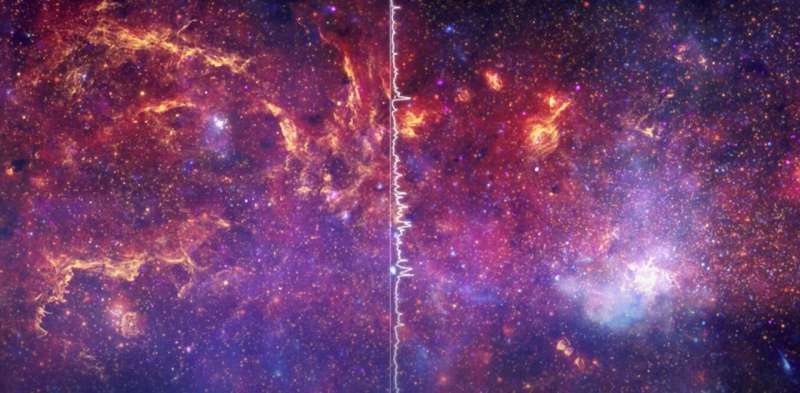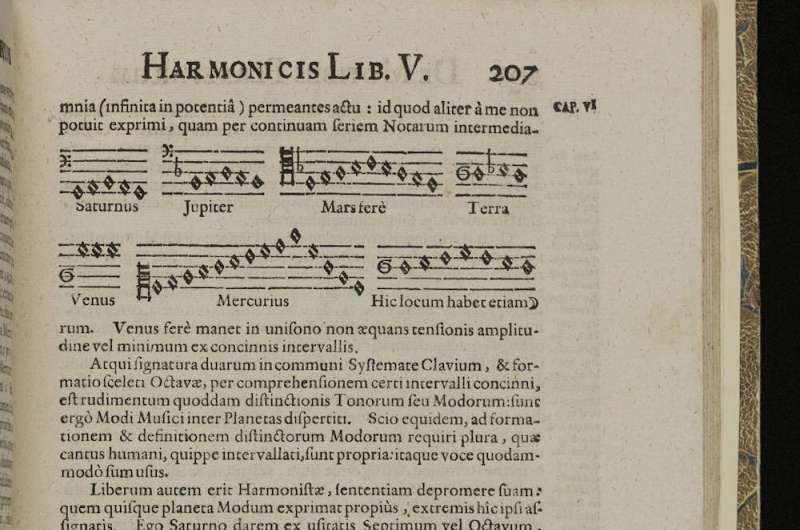This article has been reviewed according to Science X's editorial process and policies. Editors have highlighted the following attributes while ensuring the content's credibility:
fact-checked
trusted source
written by researcher(s)
proofread
A hymn to the stars: What happens when science puts the universe into music?

A little over six months ago, NASA's James Webb Space Telescope (JWST) delivered its first photographs, dazzling the world as it revealed the cosmos in glorious technicolor. The first picture transmitted in July showed a galaxy cluster located in the Southern hemisphere sky, 5.12 billion light years from Earth. In the words of US president Joe Biden, it represented "the deepest and sharpest infrared image of the distant universe" taken by humanity so far.
But NASA didn't content itself with unveiling these first JWST images visually. Tapping into the long love story between music and astronomy, scientists mapped out the colors to different pitches of sound.
Music and astronomy: An ancient love story
Music and space might not seem like natural partners—after all, no air means no sound. But to our forebears, the links were obvious. In Ancient Greece, thinkers such as Aristotle believed the Earth lay at the center of the universe. This didn't make it an unchanging ideal, however: to the ancients, terrestrial phenomena were ever-changing, a reflection of our planet's imperfection. The sky, by contrast, was seen as immutable and eternal, and so worthy of emulation.
A few of the stars moved with respect to others—so-called "planets" in the etymological sense (for "planet" means "wandering star"). The ancients knew of seven of them: Mercury, Venus, Mars, Jupiter and Saturn, plus the sun and the moon. That number would go on to inform the composition of the days of the week as well as of the musical scale.
Indeed, to the Ancient Greeks, each planet hung on a sphere, which, in turn, revolved around the Earth. Given that movement emitted sound here—such as when two objects rubbed against one another or when feet hit the ground—it made sense that the moving spheres in the cosmos should also produce sounds. Contrary to those heard on Earth, these were thought to be perfect, prompting the Ancients to use the stars as a template for terrestrial music. This is why in the Middle Ages astronomy and music were grouped together in the quadrivium, which also included arithmetic and geometry, and lay the foundations of the liberal arts education.

Plotting the stars on the musical scale
But how to weave together notes and planets? This is admittedly the trickiest part. Some scientists have linked a sound's pitch to a planet's distance, others with its speed. To add more intricacy to the compositions, at the time perceptions differed in the relative positions of the planets in the solar system.
The German astronomer Johannes Kepler (1571-1630) was one of the scientists to most notably draw on this Ancient Greek concept of "music of the spheres" (also known as musica universalis) to map out the planetary system.
Kepler's findings would catapult us into the modern cosmos: he determined that not only was the sun not at the center of the solar system—as Nicolaus Copernicus had proposed in the previous century—but also that the planets revolved around it in an elliptical rather than circular motion. As a result, distance and speed changed in the course of the orbit. It became impossible to associate a single note with a single planet, driving him to the conclusion that planets sung melodies.
Of course, all this had to remain harmonious: for a planet to produce a melody, the highest sound had to chime well with the lowest. Eventually, Kepler abandoned his tunes to concentrate on spelling out his third law on planetary motion in 1619.
While we have long left the idea of planetary spheres behind, the "music of the spheres" left its mark—even today, songs and albums continue to bear its name, including Coldplay's latest opus. The relationship between astronomy and music went on to develop further, with music inspired by astronomical concepts, objects or people, or alternatively drawing on real astronomical data.
Kepler's heirs
Rather than mapping the planetary systems, Kepler's heirs are now mapping the sky with sounds, following a few chosen rules. Intense light in an image translates into intense volume: a brighter object produce a louder sound. In turn, a sound's duration corresponds to the object's appearance: short for a star (which is basically a spot in an image), long for a nebulous cloud.
For the pitch, it could directly reflect the light frequency (higher pitch if higher frequency) or be a spatial coding (the higher the object is in the image, the higher the pitch). In that case, the image of a nebular "mountain" will produce a sonorous rise and fall. In a picture of the center of our Galaxy released for Chandra space telescope, both methods are combined: spatial coding with different light frequencies represented by different instruments (bells for X-rays, strings for visible light and a piano for infrared).
In 1606, the French philosopher Blaise Pascal wrote that "the eternal silence of these infinite spaces" terrified him. For modern day scientists, however, they're a playground of light and especially of music.
Provided by The Conversation
This article is republished from The Conversation under a Creative Commons license. Read the original article.![]()



















